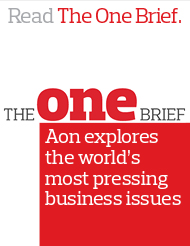Aon | Financial Services Group
Back to FSG Quick Insights | Subscribe to FSG Quick Insights >>
Early in 2022, we observed signs of pricing improvement and stabilization of terms, but also continued pressure on each of the individual lines of insurance amid ongoing COVID-19-related concerns relating to financial stability, workforce challenges, escalating defense costs and litigation trends. A deceleration of de-SPAC transactions quickly materialized mid-year and insurers were faced with focusing on growth outside of the transactional arena. The result was enhanced renewal competition and rapid pricing improvement as the year progressed.
Insurers continued to scrutinize financial conditions, return to work protocols and vaccine mandates, social engineering controls, and fiduciary liability excessive fee exposure. While insurers were concerned about pandemic-related claims and bankruptcies, EPL vaccine-related litigation was limited to a few industries, unemployment remained modest, harassment claims decreased, and private company bankruptcy filings hit a ten-year low. Excessive fee fiduciary liability litigation, on the other hand, continued, with filings against smaller plans enduring.
Capacity was stable, with most programs limited to $5M primary limits. New entrants favorably impacted excess layer pricing and stepped in to offer primary capacity on accounts in some of the more challenging industries, including healthcare, higher education, life sciences and sports organizations. Programs in those industries were marketed at a higher rate, resulting in more movement among insurers, but overall, most renewals stayed with incumbents.
Companies with over $1B in revenue continued to see additional D&O entity exclusions or anti-trust or government funding sub-limits or exclusions, depending upon individual risk profile. Retentions were also consistent, except for accounts with adverse loss history, in challenging industries, or for financially distressed companies.
As 2022 progressed rates showed improvement and we expect the private and nonprofit marketplace to be more favorable in 2023. While claim activity across all management liability lines is not likely to decrease, carrier’s books are stable after several years of rate increases, and insurers have aggressive private and nonprofit growth goals. As private and nonprofit clients enter the 2023 renewal cycle, we recommend working closely with your broker to determine automatic renewal or multi-year renewal eligibility, or competitive available renewal options early in the process.
Read more about management liability marketplace trends as we look ahead to 2023 here.
Aon is not a law firm or accounting firm and does not provide legal, financial or tax advice. Any commentary provided is based solely on Aon’s experience as insurance practitioners. We recommend that you consult with your own legal, financial and/or tax advisors on any commentary provided by Aon. The information contained in this document and the statements expressed are of a general nature and are not intended to address the circumstances of any particular individual or entity.

